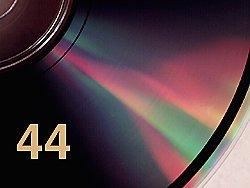|
Module 44 - A |
Updated: 07/07/2005 |
|
Audio Recording,
|
|
Cart Machines Cart machines (cartridge machines), which are still used at some facilities, incorporate a continuous loop of 1/4-inch (6.4mm) audio tape within a plastic cartridge.
Most carts record and playback 30- and 60-second segments (primarily used for commercials and public service announcements) or about three minutes (for musical selections). Audio carts are now well on their way to the Museum of Broadcasting, along with other exhibits of broadcast technology used in earlier years. Today, audio is primarily recorded and played back on hard drives, CDs, and DAT recorders.
Because of their superior audio quality, ease of control, and small size, CDs (compact discs) are a preferred medium for prerecorded music and sound effects. Although the overall diameter of a typical audio CD is only
about five inches (12.7 centimeters) across, a CD is able to hold more information
than both sides of a 12-inch (30.5cm) LP phonograph record. Plus, the frequency
response (the audio's pitch from high to low) and dynamic
range (the audio range from loud to soft that can be reproduced) are significantly
better. Although CDs containing permanently recorded audio are most common, CDRs (recordable compact discs) are also used in production. These offer all of the advantages of using CDs, plus the discs can be re-recorded multiple times. Radio stations that must quickly handle dozens of CDs use Cart/Tray CD players, such as the one shown on the right. Since the CDs do not have to be removed from this case when they are inserted into a player, the possibility of fingerprints and scratches is virtually eliminated. A space along the edge makes it possibly to label and conents Tracks and times can be electronically displayed on the front of the machine. This display can show the title of the tracks, their total times, as well as the time remaining for a selection that's being played. The CDs can start in 0.01 second, allowing for very "tight" production. CD playbacks can be programmed for instant starts at precise points. This is a significant advantage in audio production when an audio operator or a video edit controller must start musical transitions and audio effects at preprogrammed points. In mass producing CDs an image of the digital data is "stamped" into the surface of the CD in a process similar to the way LP records (with their analog signals) are produced. When a CD is played, a laser beam is used to illuminate the microscopic digital pattern encoded on the surface. The reflected light, which is modified by the digital pattern, is read by a photoelectric cell. The width of the track is 1/60th the size of the groove in an LP record, or 1/50th the size of a human hair. If "unwound" this track would come out to be about 3.5 miles (5.7 km) long. Of course, DVDs take this technology even further, but that's a story for another module. In 2004, MP3 CDs appeared that have the capacity of as many as 10 standard CDs.
If the surface of the CD is sufficiently warped because of a manufacturing problem or improper handling or storage, the automatic focusing device in the CD player will not be able to adjust to the variation. The result can be mistracking and loss of audio information.
Manufacturing problems
and dust and dirt on the CD surface can cause a loss of digital data. CD players
attempt to compensate for the loss of a signal in three ways:
Error-correcting circuitry within the CD player can detect momentary loses in data (dropouts) and, based on the existing audio at the moment, supply missing data that's close enough to the original not to be readily noticed. If the loss of data is more significant, error-correcting circuits can instantly generate data that more or less blends in with the existing audio. If this type of error concealment has to be invoked repeatedly within a short time span, you may hear a series of clicks or a ripping sound. Finally, if things get really bad and a large block of data is missing or corrupted, the CD player will simply mute (silence) the audio until good data again appears—a solution that's clearly obvious to listeners. In the second part of this Module we'll look at the latest audio recording and playback processes. |


 which
quickly led to surface noise.
which
quickly led to surface noise. Unlike an audiocassette that you have to rewind, in a cart the tape is in a continuous
loop. This means that you don't have to rewind it, you simply wait until the beginning
point recycles again. At that point the tape stops and is cued up to the beginning.
Unlike an audiocassette that you have to rewind, in a cart the tape is in a continuous
loop. This means that you don't have to rewind it, you simply wait until the beginning
point recycles again. At that point the tape stops and is cued up to the beginning.
